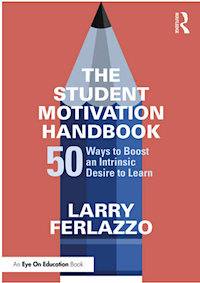How to Boost Students’ Intrinsic Desire to Learn
The Student Motivation Handbook: 50 Ways to Boost an Intrinsic Desire to Learn
By Larry Ferlazzo
(Routledge/Eye On Education, 2023 – Learn more)
Reviewed by Alexis Lecznar
Over the past 14 years as a middle school teacher, I have been driven by a goal and mindset to teach students to be prepared for the world far beyond the content of a social studies classroom.
I strongly believe that for our students to be successful in wherever life takes them, they need to have the life skills (communication, critical thinking, organization) and foundational blocks that create success – far more than they need to rotely know specific dates and people. This mindset has encouraged me to bring compassion, understanding, and community building as a teacher and leader in both my building and district.

For me to help students develop skills that will help them with their future, I need to work with them on “wanting to learn.” It is for these reasons that I was immediately drawn to Larry Ferlazzo’s book The Student Motivation Handbook: 50 Ways to Boost an Intrinsic Desire to Learn.
A guide to creating your community of learners
Practical. Resourceful. Research Driven. Larry Ferlazzo, a high school teacher himself, uses research backed strategies to build community in the classroom and drive intrinsic motivation. He shares his strategies and lessons learned to help us all create a classroom community of learners. By page 3, I had already made an annotation for my classroom theme in the upcoming school year. “…creating an overall class atmosphere of a ‘community of learners’ instead of a ‘classroom of students.’ (Ferlazzo, page 3)
Ferlazzo breaks his “50 ways to boost intrinsic motivation” into five chapters:
- Motivation in the Classroom
- What is “Autonomy” and Why is it Important?
- What is “Competence” and Why is it Important?
- What is “Relatedness” and Why is it Important?
- What is “Relevance” and Why is it important?
Each chapter provides specific strategies to boost intrinsic motivation. The why behind these strategies is explained clearly to the reader and backed up with a wide array of research. Whether you are a teacher entering your first year or your fifteenth year, this book would be helpful to your practices and instruction.
Most impressive about these strategies is that every single one came with real world, practical examples. Ferlazzo has used all of these strategies in his classroom and provides detailed and clear examples in the book as well as links for the reader to access all materials online (all of which are free). A link at the publisher’s page provides a clickable Word document with all the book’s linked references, by chapter.
How I see the book impacting my practice through the year
As an educator reading this during the summer, I am eager to start using several of these strategies to work on creating a “community of learners” instead of a “classroom of students” right away in September. However, this is not just a “professional summer read” – these strategies are written to be used all year long.
I plan on referencing this book multiple times throughout the year as the practicality, examples, and usefulness is evident on every page. It is clear that consistency and follow through with many of these strategies are what drive intrinsic motivation and a “community of learners.”
Ferlazzo circles back to building a community of learners numerous times. They are not “one and done” strategies – they require intent and consistency. The strategies help to create this community of learners, and the community of learners help to drive intrinsic motivation – the two work together.
As Ferlazzo states more than once, “the only thing worse than not giving a Check-in survey is giving one and not paying attention to the responses” (Ferlazzo, page 130). Intentional follow through is a key element with many of the 50 strategies.
I loved how practical the advice and strategies in The Student Motivation Handbook are. It’s not often you find a book full of research backed strategies as authentic as this one. Reading this book felt like having a conversation with a teacher giving their best tried and true pieces of advice – those things the veteran and great teachers just do that help make students want to be in that room.
Spoiler alert: Ferlazzo gives you 50 of those “things teachers just do” – the things that create a welcoming, engaged, and collaborative space. The fact that Ferlazzo’s examples are from classrooms make this book that much more important, in my opinion.
Another element of this book I truly enjoyed was the way in which Ferlazzo ended each chapter. The last two pages or so of each chapter present a section titled, “What Questions Can Teachers Ask Themselves to Ensure their Strategies to Promote ___ are also Culturally Responsive.” These questions invite a deep inward reflection on how we, as the teacher, are considering all of our students in our decisions.
Throughout this book you feel the great lengths Ferlazzo goes to in order to build a community of learners in his own classes and create a sense of belonging for all. I am excited to share this book with my colleagues and revisit it throughout the school year to help build my own community of learners.
Alexis Lecznar has been a middle school social studies teacher for 14 years and loves working with students while they are at a crucial developmental stage in their lives. Since entering the classroom, she has earned a M.A. in educational technology. She has also had the opportunity and joy of taking on various leadership roles within her school and district. In 2022 she was named the Michigan History Teacher of the Year by the Daughters of the American Revolution.



































